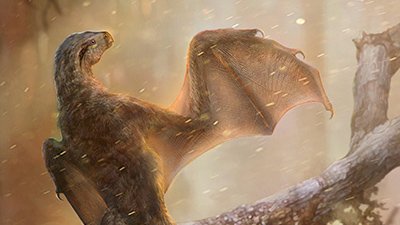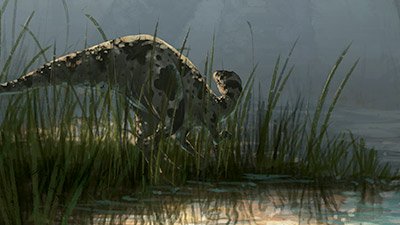Toy T. rex
Would a miniature T. rex be any less frightening than the real thing?
News Source
- BBC News: “Tiny Ancestor is T. rex Blueprint”
While newly studied fossil Raptorex kriegsteini shows the same menacing features as T. rex, in real life it would have been 90 times less massive than the iconic dinosaurs. Thus—and perhaps not surprisingly—it’s being dubbed a “missing link” between older dinosaurs and T. rex.
The fossil was apparently dug up in China illegally, after which it made its way through dealers until being sold to private collector Henry Kriegstein. He later contacted the University of Chicago’s Paul Sereno, who struck a deal to analyze the specimen. (Both Sereno and Kriegstein are co-authors of the Science paper describing the fossil.1)
The estimated date of the find is also backing up “missing link” claims: the fossil is from sediments said to be 125 million years old—60 million years older than T. rex’s historical niche. Paleontologists already proposed T. rex had evolved from a smaller ancestor, which in some way supports the “missing link” claim.
“It’s as close to the proverbial missing link on a lineage as we might ever get for T. rex,” said Sereno. “From the teeth to the enlarged jaw muscles, the enlarged head, the small forelimbs, the lanky, running, long hind-limbs with the compressed foot for hunting prey: we see this all, to our great surprise, in an animal that is basically the body weight of a human or 1/90th the size that ultimately this lineage would reach in T. rex.” (View the size difference between the T. rex and R. kriegsteini forelimbs and skulls.)
But the fossil is quite different in one important way from what paleontologists had expected. It was thought that T. rex’s body shape evolved because of its large size, not before it. Hence the words of the American Museum of Natural History’s Stephen Brusatte, who noted, “Raptorex, the new species, really throws a wrench into this observed pattern.” However, he concluded, “We can say that these features did not evolve as a consequence of large body size but rather that they evolved as an efficient set of predatory weapons in an animal that was just one one-hundredth of the size of T. rex.”
“So that means that for most of their evolutionary history, about eighty percent of the time that they were on Earth, tyrannosaurs were small animals that lived in the shadow of other types of very large dinosaur predators,” he added.
"Perhaps R. kriegsteini was the juvenile offspring of a smaller T. rex."
The team’s claim that Raptorex kriegsteini is a missing link rests entirely on the sediment-based dating of the fossil—which was done indirectly because the fossil’s original finders and specific origin are unknown. After all, a miniature T. rex said to be from the same period as all others might instead be interpreted as simply a variation in size (increasing the known size range of T. rex.). Or perhaps R. kriegsteini was the juvenile offspring of a smaller T. rex, “doubling up” explanations for its small size.
It’s a story similar to horses. Evolutionists claim (no surprise) to see an evolutionary lineage in horse fossils (some of which are likely not horses at all), ranging from very small to “normal” size. Yet that incredible range of sizes exists on earth today! The same goes for many other creatures, including humans—see the September 20, 2008, News to Note (the primary linked article no longer exists, but an online search turns up replacements).
That’s why we see R. kriegsteini not as a missing link (of course), but rather a size variation in the same created kind as T. rex (most likely).
Further Reading
-
What Really Happened to the Dinosaurs?
- Get Answers: Dinosaurs, Fossils
For More Information: Get Answers
Remember, if you see a news story that might merit some attention, let us know about it! (Note: if the story originates from the Associated Press, FOX News, MSNBC, the New York Times, or another major national media outlet, we will most likely have already heard about it.) And thanks to all of our readers who have submitted great news tips to us. If you didn’t catch all the latest News to Know, why not take a look to see what you’ve missed?
(Please note that links will take you directly to the source. Answers in Genesis is not responsible for content on the websites to which we refer. For more information, please see our Privacy Policy.)
Footnotes
- Paul C. Sereno et al., “Tyrannosaurid Skeletal Design First Evolved at Small Body Size,” Science 326, no. 5951 (October 16, 2009): 418–422, doi:10.1126/science.1177428.
Recommended Resources

Answers in Genesis is an apologetics ministry, dedicated to helping Christians defend their faith and proclaim the good news of Jesus Christ.
- Customer Service 800.778.3390
- Available Monday–Friday | 9 AM–5 PM ET
- © 2025 Answers in Genesis





